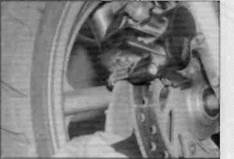
CATEGORIES:
BiologyChemistryConstructionCultureEcologyEconomyElectronicsFinanceGeographyHistoryInformaticsLawMathematicsMechanicsMedicineOtherPedagogyPhilosophyPhysicsPolicyPsychologySociologySportTourism
B ... then unscrew the pin - R and T models2.2a Remove the R-pin...
All models are equipped with a twin piston, sliding caliper, hydraulic disc front brake. R and T models have a drum rear brake and V, W, SW, X, SX, Y and SY models have a single piston, sliding caliper, hydraulic disc rear brake. The front brake caliper on R and T models is of Nissin manufacture, whereas the front and rear brake calipers on V, W, SW, X, SX, Y and SY models are of Brembo manufacture. All models are fitted with cast alloy wheels designed for tubeless tyres only. Caution: Disc brake components rarely require disassembly. Do not disassemble components unless absolutely necessary. If a hydraulic brake line is loosened, the entire system must be disassembled, drained, cleaned and then properly filled and bled upon reassembly. Do not use solvents on internal brake components. Solvents will cause the seals to swell and distort. Use only clean brake fluid or denatured alcohol for cleaning. Use care when working with brake fluid as it can injure your eyes and it will damage painted surfaces and plastic parts.
3Slide the pads out of the caliper (see illustration).Inspect the surface of each pad for contamination and check that the friction material has not worn down level with or beyond the wear limit groove in the pad edge (see illustration).If either pad is worn down to, or beyond, the wear limit, is fouled with oil or grease, or heavily scored or damaged by dirt and debris, both pads must be renewed as a set. Note: Itis not possible to degrease the friction material; if the pads are contaminated in any way they must be renewed. 4 Check that each pad has worn evenly at each end, and that each has the same amount of wear as the other. If uneven wear is noticed, one of the pistons is probably sticking in the caliper, in which case the caliper must be overhauled (see Section 3). Note: Do not operate the brake lever while the pads are out of the caliper.
5 If the pads are in good condition clean them carefully, using a fine wire brush which is completely free of oil and grease, to remove all traces of road dirt and corrosion. Using a pointed instrument, clean out the grooves in thefriction material and dig out any embedded particles of foreign matter. Any areas of glazing may be removed using emery cloth. 6 Check the condition of the brake disc (see Section 4). 7 Remove all traces of corrosion from the pad pin. Inspect the pin for signs of damage and renew it if necessary. 8 If new pads are being installed, push the pistons as far back into the caliper as possible. A good way of doing this is to insert one of the old pads between the disc and the piston, then push the caliper against the pad and disc using hand pressure. Due to the
Warning: The dust created by the brake system may contain asbestos, which is harmful to your health. Never blow it out with compressed air and don't inhale any of it. An approved filtering mask should be worn when working on the brakes. 1 On R and T models, unscrew the pad retaining pin plug then unscrew the pad retaining pin and withdraw the pin, noting how it fits (see illustrations). 2On V, W, SW, X, SX, Y and SY models, remove the R-pin and tap the pad retaining pin out of the caliper from the right-hand side using a small punch, then withdraw the pin (see illustrations). 2.3a Withdraw the pads from the caliper
Date: 2016-01-14; view: 724
|



